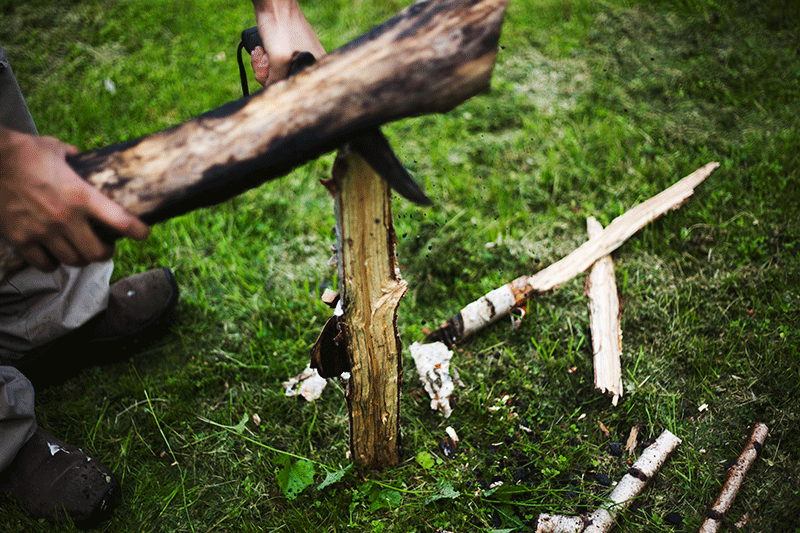Knife batoning is an essential skill for anyone who enjoys outdoor activities such as camping, hiking, or survival training. This technique involves using a knife to split wood, making it easier to create kindling, build shelters, or start a fire. In this article, we will delve into the intricacies of knife batoning, explore its benefits, and provide you with tips and techniques to master this skill effectively. Whether you are a novice or an experienced outdoor enthusiast, understanding knife batoning can significantly enhance your outdoor experience.
By the end of this article, you will have a thorough understanding of knife batoning and be well-equipped to implement this technique during your outdoor adventures. So, let’s dive in and explore the world of knife batoning!
Table of Contents
- What is Knife Batoning?
- Benefits of Knife Batoning
- Tools Required for Knife Batoning
- How to Baton Wood with a Knife
- Safety Tips for Knife Batoning
- Common Mistakes in Knife Batoning
- Alternatives to Knife Batoning
- Conclusion
What is Knife Batoning?
Knife batoning is a technique used to split wood by striking the back of a knife blade with a baton, which is typically a sturdy stick or piece of wood. This method leverages the strength of the baton to apply force on the knife, allowing it to penetrate the wood and create clean splits. It's a widely used technique among campers, survivalists, and outdoor enthusiasts due to its efficiency and simplicity.
Benefits of Knife Batoning
There are several advantages to mastering knife batoning:
- Efficient Wood Processing: Knife batoning allows you to quickly create kindling and firewood, essential for cooking and warmth.
- Versatility: This technique can be used with various types of wood, making it suitable for different environments and situations.
- Minimal Equipment: All you need is a reliable knife and a baton, making it easy to include in your outdoor gear.
- Skill Development: Learning knife batoning enhances your overall bushcraft skills and confidence in the wilderness.
Tools Required for Knife Batoning
Before you begin knife batoning, you will need the following tools:
- Knife: A fixed-blade knife with a sturdy blade is preferred, as folding knives may not withstand the force of batoning.
- Baton: A solid piece of wood, typically 1-2 inches in diameter and about 12-18 inches long.
- Wood: A suitable piece of wood to baton, preferably softwood for beginners.
How to Baton Wood with a Knife
Follow these steps to master the art of knife batoning:
- Select the Right Wood: Choose a piece of wood that is straight and dry for easier splitting.
- Position the Knife: Place the knife blade on the edge of the wood, ensuring it is perpendicular to the grain.
- Use the Baton: Hold the baton above the knife and strike the back of the knife blade with controlled force.
- Check for Progress: After a few strikes, check the depth of the cut. Adjust your technique if necessary.
- Continue Batoning: Keep striking until the wood is fully split.
Safety Tips for Knife Batoning
Knife batoning can be dangerous if not done correctly. Here are some safety tips to keep in mind:
- Wear Protective Gear: Use gloves and eye protection to shield against accidental slips.
- Maintain Control: Always keep a firm grip on the knife and baton to avoid losing control.
- Choose a Stable Surface: Batoning should be done on a stable, flat surface to prevent the wood from moving.
- Avoid Distractions: Stay focused while batoning to minimize the risk of injury.
Common Mistakes in Knife Batoning
Even experienced individuals can make mistakes when knife batoning. Here are a few common pitfalls to avoid:
- Using a Poor-Quality Knife: Ensure your knife is sharp and sturdy to avoid breakage.
- Inadequate Baton Size: Using a baton that is too small may lead to ineffective strikes.
- Incorrect Blade Angle: Make sure the knife is positioned properly to maximize efficiency.
Alternatives to Knife Batoning
If you find knife batoning challenging or unsuitable for your situation, consider these alternatives:
- Hatchet: A hatchet can be more effective for splitting larger pieces of wood.
- Saw: A saw can be used to cut wood into manageable sizes without the need for batoning.
- Firestarter Tools: Consider using firestarter tools for creating kindling without the need for splitting wood.
Conclusion
In conclusion, knife batoning is a valuable skill for any outdoor enthusiast. By mastering this technique, you can efficiently process wood for fires, cooking, and shelter building. Remember to practice safety and technique, and soon you'll find yourself confidently batonning wood in the great outdoors. If you have any questions or want to share your experiences with knife batoning, feel free to leave a comment below!
Call to Action
We hope this guide has provided you with useful insights into knife batoning. Don’t forget to share this article with fellow outdoor enthusiasts and check out our other articles for more tips and tricks to enhance your outdoor adventures.
Thank you for reading, and we look forward to seeing you back on our site for more great content!



